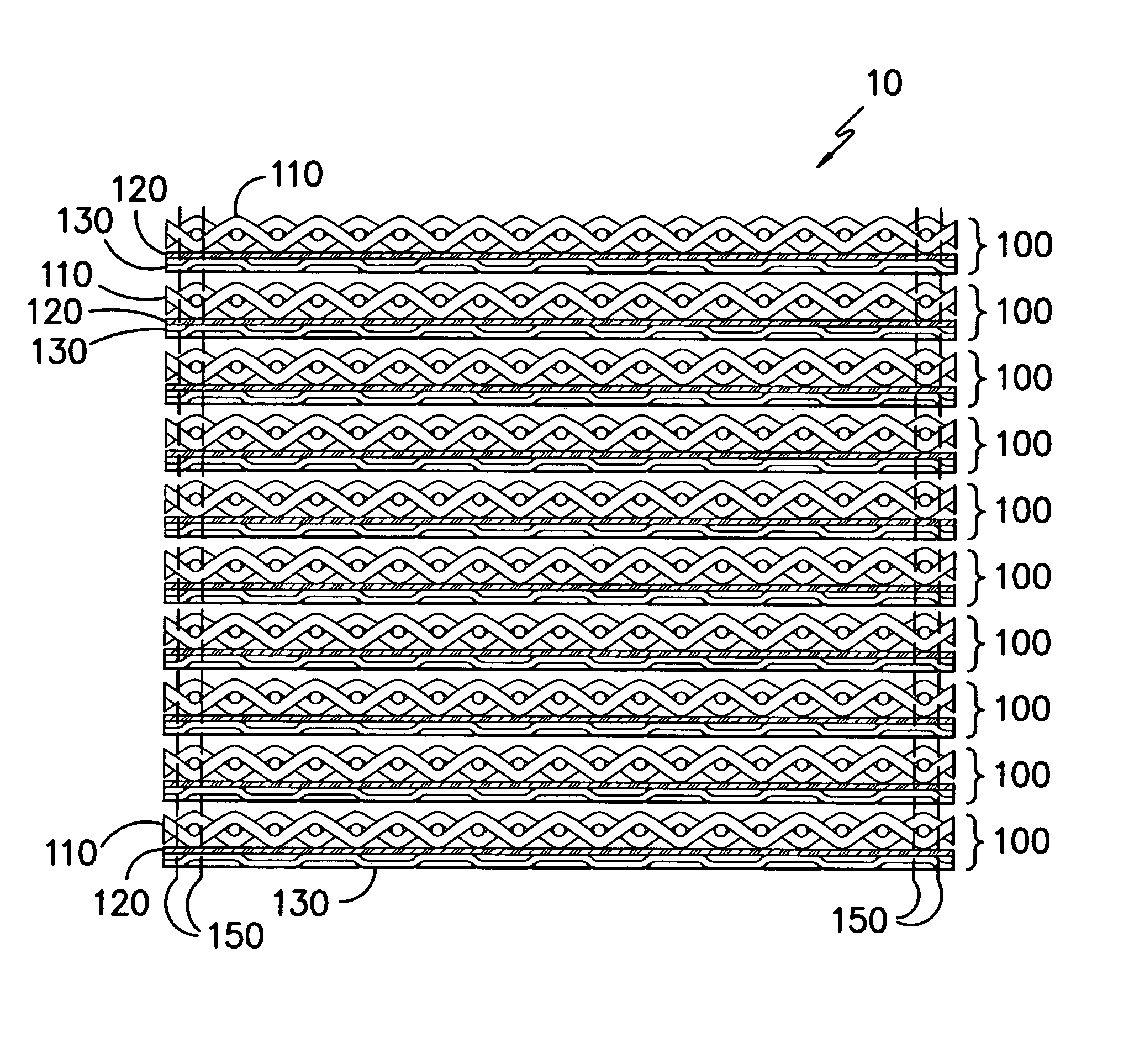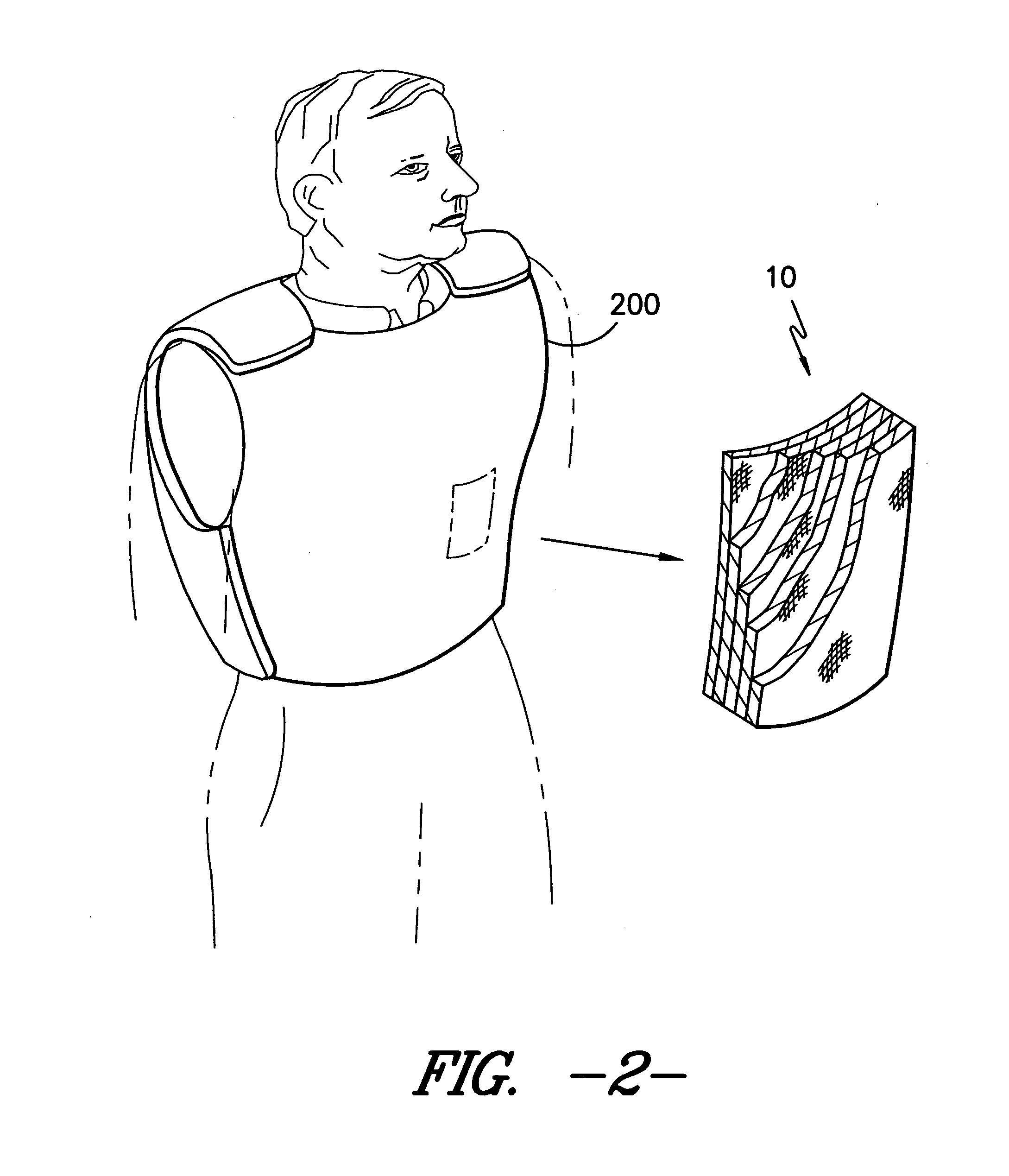Flexible spike and knife resistant composite
a composite material and flexible technology, applied in the field of flexible composites, can solve the problems of difficult to cut irregular shapes to fit the body, the weight of flexible metallic components tends to increase the weight of vests, and the material with laminated or resinated or coated fabrics is less satisfactory against knife and spike stabs
- Summary
- Abstract
- Description
- Claims
- Application Information
AI Technical Summary
Benefits of technology
Problems solved by technology
Method used
Image
Examples
examples
[0084]Various embodiments of the invention are shown by way of the Examples below, but the scope of the invention is not limited by the specific Examples provided herein.
Test Methods
Consolidated Layer Groupings Stiffness Test Method
[0085]The stiffness of the consolidated layer groupings was measured according to the modified ASTM Test Method D6828-02, entitled “Standard Test Method for Stiffness of Fabric by Blade / Slot Procedure”. The sample size used was 1 inch by 4 inch and the width of the slot was set to 20 mm. In order to minimize the effect due to surface friction, a thin Teflon sheet was inserted between the sample and the slot during measurements. For nonsymmetrical configurations, the stiffness value listed is an average of the stiffness measurements in all orientations.
Knife and Stab Resistance Test Method
[0086]The stacked consolidated layer groupings (The number of consolidated layer groupings was chosen such that the total areal density is approximately 6.40 kg / m2) were ...
invention example 2
[0105]An unconsolidated layer grouping for Invention Example 2 was formed by stacking in order a SR-1A layer, a AD-1 layer, a KR-1 layer, an AD-1 layer, and an SR-1A layer. The unconsolidated layer grouping was consolidated into a consolidated layer grouping by a compression molding process with 300° F. Platen temperature and 300 psi pressure.
[0106]The consolidated layer grouping had an areal density of 0.54 kg / m2. The stiffness and normalized stiffness with respect to its areal density for Invention Example 2 is shown in Table 1. Twelve (12) consolidated layer groupings with a total areal density of 6.48 kg / m2 were stacked together and encased in a nylon bag. The assembly was then tested for knife and spike stab resistance. The penetrations of the P1B knife and spike are shown in Table 2.
invention example 3
[0107]An unconsolidated layer grouping for Invention Example 3 was formed by stacking in order a SR-1A layer, an AD-2 layer, a PC-1 layer, an AD-2 layer, and a KR-1 layer. The unconsolidated layer grouping was consolidated into a consolidated layer grouping by a compression molding process with 300° F. Platen temperature and 300 psi pressure.
[0108]The consolidated layer grouping had an areal density of 0.495 kg / m2. The stiffness and normalized stiffness with respect to its areal density for Invention Example 3 is shown in Table 1. Thirteen (13) consolidated layer groupings with a total areal density of 6.44 kg / m2 were stacked together and encased in a nylon bag. The assembly was then tested for knife and spike stab resistance. The penetrations of the P1B knife and spike are shown in Table 2.
PUM
| Property | Measurement | Unit |
|---|---|---|
| diameter | aaaaa | aaaaa |
| diameter | aaaaa | aaaaa |
| diameter | aaaaa | aaaaa |
Abstract
Description
Claims
Application Information
 Login to View More
Login to View More - R&D
- Intellectual Property
- Life Sciences
- Materials
- Tech Scout
- Unparalleled Data Quality
- Higher Quality Content
- 60% Fewer Hallucinations
Browse by: Latest US Patents, China's latest patents, Technical Efficacy Thesaurus, Application Domain, Technology Topic, Popular Technical Reports.
© 2025 PatSnap. All rights reserved.Legal|Privacy policy|Modern Slavery Act Transparency Statement|Sitemap|About US| Contact US: help@patsnap.com



